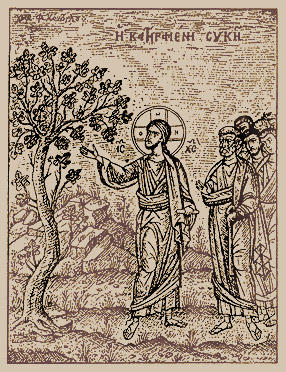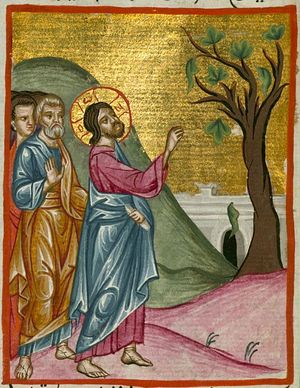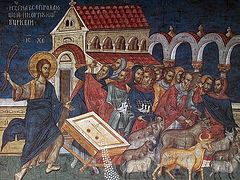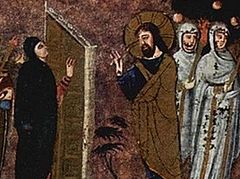In the name of the Father and of the Son and of the Holy Spirit!
Today, on Great and Holy Monday, according to the Church calendar, we remember how the Lord drove the merchants out of the Jerusalem Temple and cursed the barren fig tree.
These events, these actions of Christ, incomprehensible at first glance, evoke confusion and misunderstanding. Why was the fig tree cursed if Christ came to it before it was time for gathering figs (Mk. 11:13)? But such deeds of the Savior, such as the cursing of the fig tree, are full of symbolic and spiritual significance if you look at the details closely.
After His triumphant entry into Jerusalem, Christ passed the night in Bethany with His disciples. In the morning, going to the Temple, He became hungry. Christ never used His Divine strength to satisfy His human needs, but resorted to human means, spurning the devil’s temptation to create bread from stones.
When the fig tree appeared in the distance, covered with leaves, Christ approached it as a man. The tree’s open leaves suggested that the fig tree would have fruit, as fig trees first give fruit and then leaves. Inasmuch as the time for gathering figs had not yet come (cf. Mk. 11:13), and the early fruits were not yet picked, it could have been expected to find at least unripe, green figs. However, drawing nearer, the Lord discovered that there were neither green nor last year’s fruits on it. That means the tree, unseasonably covered with leaves, was completely fruitless.
St. Ephraim the Syrian marvels on this point: “Why did this sweet Benefactor, Who everywhere revealed the great in the small and fullness in want, command the fig tree to wither? He healed all human illnesses, He turned water into wine, from a few loaves He made many, He opened the eyes of the blind, he cleansed the lepers and the dead he raised up to life; only one fig tree He directly commanded to wither…”
St. Ephraim then responds that Christ performed many miracles but was still crucified. Some might surmise because of this that His strength was depleted. In preclusion of this, with the help of a soulless plant that dried up, He showed that with a word He was able to destroy also His crucifiers. As He subsequently said to Simon Peter: Put up again thy sword into his place: for all they that take the sword shall perish with the sword. Thinkest thou that I cannot now pray to my Father, and he shall presently give me more than twelve legions of angels? (Mt. 26:52-53). That means that Christ hungered as a man, but manifested His power over the fig tree as God.
Seeing this unusual miracle, His disciples were amazed: Master, behold, the fig tree which thou cursedst is withered away (Mk. 11:21). To this, Jesus said, Have faith in God … whosoever shall say unto this mountain, Be thou removed, and be thou cast into the sea; and shall not doubt in his heart … those things which he saith shall come to pass (Mk. 11:23). In this “moving of the mountain” is an example that for faith, free from doubts, nothing is impossible. Therefore, we should ask about everything in prayer with faith in order to receive it. But, as St. Mark the Evangelist notes, the condition for the effectiveness of prayer is the forgiveness of the sins of others: But if ye do not forgive, neither will your Father which is in heaven forgive your trespasses (Mk. 11:26). The Lord’s words and deeds do not diverge; therefore we can presume that He cursed the fig tree “not from evil.” He forgave the Jews who crucified Him. And that means the withering of the fig tree was an exclusively symbolic act—as a sign of the Divine might of Christ, the Son of God.
 Проклятие смоковницы
Проклятие смоковницы According to the Old Testament, figs were attributed a healing power, in particular, it was considered that a “lump of figs” healed boils (cf. Is. 38:21). The fig tree was among the seven plants and foods that symbolize the riches of the Promised Land (cf. Deut. 8:8). Fig trees were planted in vineyards (cf. Lk. 13:6) so the grape vines would wrap around the trunk of the trees. The expression “to live under a vineyard and fig tree” allegorically meant peace and prosperity (cf. 3 Kg. 4:25, 4 Kg. 18:31, Mic. 4:4, Zech. 3:10).
But in addition to natural properties, the fig tree also had a symbolic meaning. For the teachers of Israel, the rabbis, it was a symbol of wisdom. One of the tractates of the Talmud records a statement from Rabbi Yohann: “As a fig tree—at any time when a man touches it he finds fruit on it, such are the words of the Torah—at any time when man pronounces them, he finds meaning in them” (Eruvin 54 a, b). The Jewish sage promises fruits from the Law of Moses “at all times.” This seems to be a kind of maximalism, since a winter fig tree doesn’t give any fruit. When Christ came to a budding fig tree in April seeking fruit, He found nothing. Symbolically, He didn’t find that good fruit that the rabbis promised “at all times.” And as a counter to their claims of maximum wisdom, the Lord declared, Let no fruit grow on thee henceforward for ever (Mt. 21:19).
The fig tree immediately withered to its root (cf. Mt. 21:20, Mk. 11:20). It was a visible miracle, obvious to all those around. But at the same time, it was a symbolic, figurative miracle.
Six months before His salvific suffering, the Lord told the parable of the barren fig tree (cf. Lk.13:6-9): That the owner of a vineyard looked for fruit for three years, but not finding any, he decided to cut down the barren tree; but the dresser implored the master: Let it alone this year also, and I will dig around it and fertilize it. If after that it doesn’t bear fruit, then chop it down.
Exactly six months after he spoke this parable, a few days before the Jewish Passover, God’s time for waiting ran out. Almost four years of the Savior’s ministry had passed, during which He abundantly watered the soil of human hearts with the “living water” of His preaching. But the fig tree of the Jews remained fruitless. But because the wood of a fig tree is not suitable for any construction needs, such a tree, bearing no good fruit, is hewn down and thrown into the fire (Mt. 3:10, 7:19, Lk. 3:9).
We cannot but be surprised that the Lord came to do only good and to improve everything, but at least three times He commits destructive actions. He drowned a herd of pigs that the non-believing inhabitants of Gadarene country would, at least because of their material losses, go out to meet Him. He opened the tombs of the departed saints that after Christ’s death on the Cross they would leave their graves and appear to many (cf. Mt. 27:52-53). He also withered the fig tree to show that the Jewish people would be rejected for their disbelief in the Son of God.
Thus, the cursing of the fig tree became a symbol of the rejection of those who have only the external appearance of fulfilling the Law, but in reality bear no good fruit.
Condemning the Jews to desolation, the Lord foretold that the Kingdom of God would be taken from them and be given to the people who bear its fruits (Mt. 21:43). We, Christians, are this “new people.” We are given the promises of the Kingdom of God, and fruit is now expected from us. But you should ask yourself: If God rejected His chosen people, rooted in Biblical tradition, for a lack of good fruit, then what will be with us with our wild olives, which, according to the apostle Paul, were grafted on in place of the broken branches (cf. Rom. 11:17), if we do not bring forth good fruit?
The Gospel story is not just an event of the historical past, but a symbol, a prototype of what can happen in the future. Any tree not bearing good fruit is cut down and thrown into the fire. God does not need just the leaves of the virtues—external, empty piety. God needs the real fruit of repentance (cf. Mt. 3:8)—hearing the word of God and fulfilling it (cf. Mt. 13:13).
Prayerfully following, step by step, the days of Holy Week, it would be good for us to honestly ask ourselves: O my soul, when the day of harvest comes and the dresser comes “in His time” to gather the fruit, will He find only leaves and a dry, fruitless tree, unfit to be in His Kingdom? Amen.





